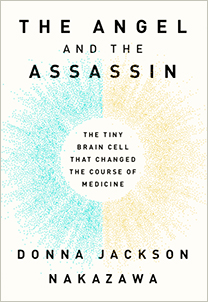Healing from Childhood Trauma + Building a New Community

Do you feel you have enough connection and community in your life? I’ve been missing it. My family and lifelong friends fulfill my longing for deep personal connection but sometimes – especially in an era of digital overwhelm, fraught interactions on social media, and…
How adverse childhood experiences or ACEs impact your current wellbeing

Often, people who have a history of trauma in childhood find themselves struggling to flourish in adulthood. Trauma affects the brain in ways that can make you more likely to experience difficulty when faced with emotionally stressful and demanding situations in your relationships, at work, and as a parent. Throughout my life, both growing up and as an adult, I’ve faced a number of challenging life experiences, stressors, and traumas, and I understand this struggle on a deep, intrinsic level. I’ve learned, not only for myself, but through my many years reporting as a science journalist, that chronic unpredictable stress in childhood affects the architecture of the brain in ways that can impact negatively our everyday life. And yet it is possible though to create new, more powerful healing possibilities for inner peace and flourishing. The brain is wonderfully neuroplastic. And it’s never too late to begin the healing process. What are adverse childhood experiences (ACEs)? The term adverse childhood experiences refers to chronic, unpredictable stressors that children and teenagers encounter while growing up. The original ACEs questionnaire was first created in 1995 by a team of physicians who asked thousands of patients about their experiences in childhood, and then compared those childhood experiences to patients’ adult health records. This original ACEs survey asks about 10 categories of adversity in childhood.These include facing physical, emotional, or sexual abuse; physical or emotional neglect; and experiencing different types of familial dysfunction, including growing up with a parent who suffered from a mental illness; or who had an addiction; or having parents who separated or divorced; or losing a parent. Our understanding of ACEs has since expanded to include growing up facing poverty, racism, community violence, and other environmental stressors such as the pandemic and climate change. Adverse childhood experiences turn out to have a profound effect on adult health. Over 2,000 studies have shown that individuals with ACEs scores of 2 or more are more likely to develop physical and mental health concerns in adulthood. This relationship between adversity in childhood and health issues in adulthood is dose-dependent. In other words, the more categories of ACEs you experienced as a child, the greater the likelihood of later experiencing physical and mental health disorders in adulthood. For instance, those with an ACE score of 3 have a 60 percent increased risk of later developing an autoimmune disease, such as lupus, multiple sclerosis, or Type 1 diabetes. And those with an ACE score of 4 or more are four times more likely to experience depression in adulthood. Trauma and the brain Adversity in childhood can change the brain in myriad ways, altering neural connectivity in the amygdala, the alarm center of the brain; the hippocampus, where you process memories and emotions; and the pre-frontal cortex, the decision-making center of your brain. Changes also occur in how well these areas communicate and network with each other in what’s known as the connectome of the brain. How brain changes affect you These changes can profoundly affect how you feel on a day-to-day basis, including how well you’re able to: You may find yourself either overreacting or underreacting to the world around you more than you’d like, or feel powerless about how you can exert influence over your history of trauma and adversity, or experience a sense of inertia or hopelessness about how you can manage chronic stressors now. What can you do? You can begin to change the legacy of the past by learning and applying neuroscience-based techniques that have a self-calming and self-regulating effect on you, and doing so in a way that is compassionate, patient, kind, and accepting of yourself. Often, those with a history of trauma have more difficulty showing loyalty to themselves, engaging in self-care, and waking up on their own side. The invitation is to become the “general contractor” of your own well-being and utilize simple, neuroscience-based tools to help replace old neural pathways that no longer serve you with neural pathways that promote your healing and flourishing. This is a process that I call Neural Re-Narrating™. I know how difficult this past year has been for all of us. Many people with ACE’s are finding that the early #trauma and sense of unsafety they endured growing up are being re-triggered during these fear-laden times, amidst the Covid-19 pandemic, political upheaval, and feeling isolated. To help address the stress and uncertainty we are all facing, I’ve created a new course, Your Healing Narrative: Write-to-Heal with Neural-Re-Narrating™️, to help you work through your ACE’s and become resilient in the face of current stressors. In this course, I teach you a new way to talk to yourself by intertwining writing prompts with mind-body exercises to signal your nervous system to calm down, reverse negative self-talk, and begin to recover from ACEs. This program combines a series of writing prompts with mindfulness techniques and the latest neuroscience to help you engage in Neural Re-Narrating™—creating a new, more powerful and resonant healing narrative that will help you change neural pathways in ways that will help you to flourish in your current life, even in these unprecedented times of adversity. Learn more here.
How to care for yourself during difficult times

Many people with #ACE’s (Adverse Childhood Experiences) are finding that the early #trauma and sense of unsafety they endured growing up are being re-triggered during these fear-laden times, amidst the #Covid #pandemic, political upheaval, and feeling isolated. Stress and uncertainty can trigger old, sticky feelings of fear, anxiety, or loss from long ago and bring up new, painful negative thoughts and physical symptoms. This can be true even when we’ve worked really hard to resolve our trauma. It can feel like we’re backsliding. I know that this is certainly the case for me, and I know, from so many of you who’ve reached out to me, that this is also the case for many of you. So here’s a gentle reminder. It’s so important to stop, pause, and take care of yourself during these difficult times, as often as you need to. It is OKAY to take a break whenever you need to, even if it’s every twenty minutes. Go for a walk. Order yourself some flowers and put them in a favorite vase. Do five minutes of deep breathing. Call a friend. Reach out to a trusted mental health care practitioner. Do all of the above. Whenever I am triggered in my personal life and old fears emerge (which is often these days), I return to the many different tools in my toolbox. One is a series of basic breath techniques that help me move through old sticky feelings and dissipate the fear, tension, and uncertainty I feel. To inspire you, here’s a quick review of the science on how breathing techniques can help you to calm your nervous system by activating the parasympathetic nervous system (what I like to call the Purr Now System), or PNS, which helps to boost the relaxation response. Oxygenating the Brain Your nervous system is comprised of an intricate network that carries messages from the brain to the body—telling you whether you are safe or not safe—in order to help you regulate your bodily functions and prepare for any possible situations, interactions, or challenges in your environment for which you may need to prepare. This network is a two-way superhighway of messaging. Messages rise from the body to tell the brain whether you’re safe, and the brain sends messages to the body about whether you need to prepare for any potential threat. This communication is constant, and one of the ways in which the body and brain communicate is through the breath: You take in 25,000 breaths a day. Breathing Too Fast If your breath is shallow, or coming quickly, as it is when you are stressed, the brain gets the message to act and respond as if you’re in physical danger. Respiratory messages take top priority when it comes to getting the brain’s attention. Breathing and Emotions Your emotional state of mind affects the rate, depth, and pattern of your breath and vice versa. Manipulating the breath in ways that match up with a particular emotion—such as fear, rage, joy, or contentment—can account for as much as 40 percent of how you feel emotionally. Think of screaming out loud in pain, holding your breath in fear, laughing with gladness, sighing with relief, or breathing in deeply as you drink in a beautiful scene in nature. Breathing Technique According to decades of research, the most beneficial breath sequence for stimulating the positive healing power of the parasympathetic nervous system (PNS), calming your brain and body, and managing anxiety is breathing in for 5½ seconds and breathing out for 5½ seconds. It can also help to make your exhale last longer than your inhale. Filling your diaphragm—by pushing your belly out like a Buddha’s belly—also helps push blood into the heart and slow your heart rate. Slowing your heart rate helps to pump blood throughout the body, thus oxygenating the body and brain. This helps stimulate the PNS and the relaxation response. Breathing vs. Medication Although many medicines can temporarily dampen the stress response and the sympathetic nervous system (or what I call the Stress Now System), there are no medications you can take to boost the rest and relaxation response, or the parasympathetic nervous system. Slow, gentle breathing can stimulate the relaxation response rapidly and effectively—in as little as five minutes. The oldest tool we have is the most powerful—the breath—and it has zero side effects. Stop the negative self-talk and soothe your nervous system The events and stressors of this past year have prompted me to create a new course, Your Healing Narrative: Write-to-Heal with Neural-Re-Narrating™️, to help you work through your #ACE’s and become resilient in the face of current stressors. In this course, I teach you a new way to talk to yourself by intertwining writing prompts with mind-body exercises to signal your nervous system to calm down, reverse negative self-talk, and begin to recover from #ACEs. This program combines a series of writing prompts with mindfulness techniques and the latest neuroscience to help you engage in what I call Neural Re-Narrating™—creating a new, more powerful and resonant healing narrative that will help you change neural pathways in the brain in ways that will help you to flourish in your current life, even in these times of adversity. Learn more here.
Why Girls Who Face Toxic Stress are More Vulnerable to Adult Illness: The Shocking Relationship Between Being Female, #ACEs, Autoimmune Disease and Depression
Hi All, This blog is about WHY Adverse Childhood Experiences are a #METOO ISSUE. I want to talk about how and why toxic childhood stress – also as #ACEs — is a #metoo issue of the greatest magnitude. For girls and for the adult women they become. One thing readers know about the work I do and the books I write, including Childhood Disrupted, The Autoimmune Epidemic, and The Last Best Cure, is that I focus on the intersection of neuroscience, immunology and emotion – while shining a spotlight on WOMEN’s experiences. Connecting these dots is always an underlying theme in my work. Women, girls, toxic stress, the female brain and immune system, autoimmune disease and chronic physical and mental illness — if you care about any of these, keep an eye out for my upcoming three-part blog series in which I delve into the scientific links between them all. Today I’m posting the first part of my three-part exploration on Growing Up With Female Adversity: The Female Body and Brain on Toxic Stress. (For those of you who read this introduction to my three-part series in my heads-up post yesterday, skip down below to PART ONE…) I’ve written this blog, and am offering it up freely, because I think it’s crucial that we address the unique way in which the female brain and immune system respond to environmental influences, including #ACEs, and how, in turn, this unique female brain-immune response contributes to girls being several times more likely to later develop autoimmune diseases, depression, anxiety disorders, and so many other chronic illnesses. I’m going to break down for you, in a way no one else has, or will, how and WHY Adverse Childhood Experiences and toxic childhood stress are a #metoo issue of the greatest magnitude. For girls and for the adult women they become. In it, I’m offering up the term — and hashtag — #FemaleAdversity — to refer to the chronic societal stress girls face growing up. Girls not only come of age with higher rates of #AdverseChildhoodExperiences, including verbal, emotional, sexual and physical abuse, girls also have to find their way to a healthy adulthood and sense of self amidst cripplingly narrow societal expectations regarding what constitutes acceptable female beauty and behavior. All this is intensified, 24/7, by imagery of effortless female perfection on social media and in media in general. Meanwhile, girls are witnessing the sexual harassment and sexism so many adult women endure. Over time, this #FemaleAdversity can take a toll on girls’ and women’s immune systems, bodies, and brains in unique ways. The timing for this discussion seems apt, as today we come to the end of #autoimmunediseaseawareness month as well as #womenshistorymonth and enter #childabuseprevention month. A fitting moment to delve into all of these issues. So, Today, I’m sharing: PART ONE: Why Girls Who Face #ToxicStress are More Vulnerable to Adult Illness: The Shocking Relationship Between Being Female, #ACEs, #AutoimmuneDisease and #Depression. To get personal for a moment, the reason I focus so strongly, as a science journalist, on this intersection between neuroscience, immunology, emotion, toxic stress, and being female is, in part, due to my own autoimmune history. I’ve struggled most of my adult life with the lingering physical effects of having been paralyzed twice with Guillain Barre Syndrome. I’ve had a pacemaker since I was 28. I’ve struggled with peripheral neuropathy, chronic neuromuscular pain, thyroiditis, leukopenia and other medical issues throughout my adult life. But I’m hardly alone in all this; so many of you, my readers, have faced similar and often much more difficult health issues than I have. My own experience is merely what lead me, as a career science journalist, to investigate the intersection of neuroscience, immunology and the deepest inner workings of the human heart. What KEEPS ME GOING is the way I’ve been moved, time and again, by the hundreds of thousands of female readers who’ve shared with me their struggles, in the face of #trauma, #autoimmunedisease, #chronic illness, #depression.Wanting to help ease that suffering propels ME to uncover new understanding, new answers and insights that can change lives. The reason I shine an up-close light on how women’s bodies, brains and immune systems are impacted in unique ways by toxic stress and emotion, and other environmental triggers, is because the science in this area is exciting and also under-reported. And the reason this science is under-reported is because it can be complex and hard to unpack in a media era that all too often relies on simplistic, broad-brush headline-centric, click-bait reporting. If you follow my work you already know that research shows that #ACEs, such as being chronically put down or humiliated, living with a depressed, mentally ill, or alcoholic parent, losing a parent to divorce or death, being emotionally neglected, physically or sexually abused, as well as many other types of toxic childhood stressors, are linked to a much greater likelihood of developing autoimmune disease, heart disease and cancer in adulthood. Having experienced 6 categories of childhood adversity can take 20 years off your lifespan. That’s because toxic stress changes the way our immune system responds to stressors in the future. When kids and teens experience chronic adversity, inflammatory chemicals begin to flood a child’s body and brain, plunging the body into a state of chronic hypervigilance. Our genes are ALWAYS in a back and forth dance with our environment. If you’re a child growing up in an environment that is chronically stressful, and don’t have reliable adults to turn to, that meets the definition of toxic stress. Toxic childhood stress begins to cause changes in the architecture of the developing brain, and it engenders profound epigenetic changes in the genes that oversee the stress response. In fact, Yale researchers recently found that children who’d faced Chronic Unpredictable Toxic Stress (what I term C.U.T.S.) demonstrate changes “across the genome” in genes that oversee the stress response. These changes re-set the stress response to “high” for life. They also showed changes in genes that play
Childhood Trauma Leads to Lifelong Chronic Illness — So Why Isn’t the Medical Community Helping Patients?
Hi All, I hope you’ll enjoy this essay I wrote for Huffington Post, “Childhood Trauma Leads to Adult Chronic Illness — So Why Isn’t the Medical Community Helping Patients?” I put my heart into it. My team has also gathered some of readers’ favorite articles and video clips in which I address the link between childhood trauma, and adult illness, and how we can heal, and put them all together in my most recent newsletter! You can find all that here: http://eepurl.com/b_AhU5 (If you want to receive future newsletters, you can “subscribe” in the top left menu in order to join our mailing list.) To Your Healing, Donna Save Save Save Save Save Save





